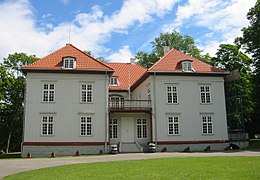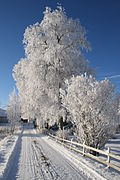| Eidsvoll Municipality Eidsvoll kommune | |
|---|---|
| Municipality | |
 Sundet, the municipal center, with the old bridge Sundet, the municipal center, with the old bridge | |
 Flag Flag Coat of arms Coat of arms | |
 Akershus within Norway Akershus within Norway | |
 Eidsvoll within Akershus Eidsvoll within Akershus | |
| Coordinates: 60°21′N 11°15′E / 60.350°N 11.250°E / 60.350; 11.250 | |
| Country | Norway |
| County | Akershus |
| District | Romerike |
| Administrative centre | Sundet |
| Government | |
| • Mayor (2023) | Nina Kristengård (Høyre) |
| Area | |
| • Total | 457 km (176 sq mi) |
| • Land | 385 km (149 sq mi) |
| • Rank | #222 in Norway |
| Population | |
| • Total | 24,647 |
| • Rank | #46 in Norway |
| • Density | 54/km (140/sq mi) |
| • Change (10 years) | |
| Demonym | Eidsvolling |
| Official language | |
| • Norwegian form | Bokmål |
| Time zone | UTC+01:00 (CET) |
| • Summer (DST) | UTC+02:00 (CEST) |
| ISO 3166 code | NO-3240 |
| Website | Official website |
| Data from Statistics Norway | |
Eidsvoll (pronounced [ˈæ̀ɪdsvɔɫ] ; sometimes written as Eidsvold) is a municipality in Akershus county, Norway. It is part of the Romerike traditional region. The administrative centre of the municipality is the village of Sundet.
General information
Etymology
The first element is the genitive case of the word eid (Old Norse: eið) and the last element is voll (Old Norse: vǫllr) which means "meadow" or "field". The meaning of the word eid in this case is "a road passing around a waterfall". People from the districts around the lake (Mjøsa) who were sailing down the river Vorma, and people from Romerike sailing up the same river, both had to enter this area by passing the Sundfossen waterfall. Because of this, the site became an important meeting place long before the introduction of Christianity. Prior to 1918, the name was spelled "Eidsvold". The town of Eidsvold in Queensland, Australia and Eidsvold Township, Lyon County, Minnesota, United States still use this old spelling.

Eidsvoll Church
Eidsvoll Church (Eidsvoll Kirke) is a cruciform church from approx 1200. It is part of the Norwegian Church and belongs to Øvre Romerike deanery in the Diocese of Borg. The Romanesque building is in stone. Eidsvoll church is repeatedly burned and rebuilt. The old church records were lost in a fire. The altarpiece in Eidsvoll church is from 1765. It is a wooden structure with three floors, decreasing towards the top, where each floor concludes with gilded pilasters with capitals and rococo decor on each side of a painting. The altarpiece was restored after a fire in 1883, the next restoration occurred in 1915 and a third restoration occurred late 1960s. Access to the church is a well traveled tourist destination is via Rv181 and Fv502 / Rv177. Pilegrimsleden goes through Eidsvoll. Eidsvoll church is one of the more prominent stops along the path, which was officially opened on 16 June 2002.
Coat-of-arms
The coat-of-arms is from modern times. They were granted on 20 November 1987. The arms show a balance as a symbol of justice. In the early Middle Ages a local court was established in Eidsvoll.
| Country of origin | Number |
|---|---|
| 559 | |
| 236 | |
| 187 | |
| 179 | |
| 137 | |
| 134 | |
| 132 | |
| 104 | |
| 97 | |
| 96 |

History
The parish of Eidsvold was established as a municipality on 1 January 1838 (see formannskapsdistrikt). The municipality of Feiring was merged with Eidsvoll on 1 January 1964.
Eidsvoll is mentioned in Old Norse manuscripts. In the 11th century, it became the site of court and assembly (ting) for eastern parts of Norway, replacing Vang, now a part of Hamar in Hedmark. Because of its access to the river Vorma and the lake Mjøsa, Eidsvoll has long provided a thoroughfare to northern parts of inland Norway. Historically the main industry of Eidsvoll was agriculture, though the soil is rich in clay. Eastern parts of Eidsvoll were for a short time the site of a minor gold rush when gold was found in 1758, and these areas are still known as Gullverket.
Eidsvoll Verk was opened to smelt iron ore by King Christian IV of Denmark in 1624, relying on the excellent water power from the Andelva river. In 1688, it was owned by the director of the Kongsberg Silver Mines, Schlanbusch, and remained in his family until 1781. Carsten Anker came into possession of works in 1794, at which time it was in decay since many of the surrounding forests required for charcoal had been depleted. He restored it and set up the production of stoves and similar iron goods. He also took residence in Eidsvoll in 1811, rebuilding the manor house which is now the Eidsvollsbygningen, the site where the constitutional assembly met to draft and sign the Constitution of Norway on 17 May 1814. Eidsvollsbygningen is today a famous museum.
In 1854, Eidsvoll became the end point for the first railroad line in Norway from Oslo. This became the transit point for travel with the steamship Skibladner to Hamar, Gjøvik, and Lillehammer on the lake Mjøsa. In addition to the historic Eidsvoll Church, Eidsvoll is the site of the Langset Church (Langset kirke) which dates to 1859 and the Feiring Church (Feiring Kirke) which dates to 1875.
Eidsvoll gallery
-
 Steamer Skibladner, Dampskibsbryggen and Eidsvold Hotel
Steamer Skibladner, Dampskibsbryggen and Eidsvold Hotel
-
 Eidsvollsbygningen at Eidsvoll Verk, site of the constitutional assembly
Eidsvollsbygningen at Eidsvoll Verk, site of the constitutional assembly
-
Eidsvoll Church altar
-
Langset Church
-
 Winter at Bøn in Eidsvoll
Winter at Bøn in Eidsvoll
Geography
Eidsvoll municipality is bordered on the north by Østre Toten (in Oppland county on the west side of Mjøsa) and by Stange (on the east side of the lake) and to the east by Nord-Odal (both in Hedmark county). In the county of Akershus to the southeast lies Nes, to the south lies Ullensaker, and to the west lies Nannestad and Hurdal.
In addition to being a commuter town for Oslo, it also has agriculture and forestry industries. The main population and commercial centres are Sundet and Råholt.
Notable residents


- Henrik Wergeland (1808–1845) poet, writer and playwright; brought up in Eidsvoll; son of Professor Nicolai Wergeland (1780–1848)
- Alf Collett (1844–1919) a Norwegian writer, genealogist and historian
- Hans Langseth (1846–1927) Norwegian-American world record holder for the longest beard
- Cecilie Thoresen Krog (1858–1911) feminist pioneer, first female university student in Norway
- Fredrikke Waaler (1865–1952) composer, violinist and proponent for women's rights
- Maja Flagstad (1871–1958) a pianist, choral conductor and répétiteur
- F. Melius Christiansen (1871–1955) Lutheran choral conductor in Marinette, Wisconsin
- Arne Ekeland (1908–1994), artist, lived and worked in Bøn his entire life
- Ola Skjåk Bræk (1912–1999), minister of industry, born and raised in Eidsvoll
- Per Gjestvang (1915–2002) a veterinarian, resistance member, military officer and politician
- Dagmar Lahlum (1923–1999), resistance worker in WWII, fiancée of Eddie Chapman
- Åsmund Lønning Strømnes (1927–2009), professor of education; lived in Eidsvoll
- Leif Johansen (1930–1982) an economist and professor
- Sivert Donali (1931–2010) a Norwegian sculptor, lived in Feiring from 1973
- Drude Berntsen (born 1939) a computer scientist, director of Norwegian Computing Center
- Kari Hag (born 1941) mathematician, researched complex analysis on quasicircles
- Siv Stubsveen (born 1968) a Norwegian model, saleswoman and media personality
- Stian Carstensen (born 1971) a multi-instrument jazz musician, member of Farmers market
- Jan Gunnar Røise (born 1975) a Norwegian theatre and film actor
- Stella Mwangi (born 1986) a Kenyan-Norwegian singer, musician, songwriter and rapper.
- Alexandra Rotan (born 1996) a singer for Norway in the Eurovision Song Contest 2019

Sport
- Tormod Knutsen (born 1932) a retired Nordic combined skier, silver and gold medallist at the 1960 & 1964 Winter Olympics
- Ole Einar Martinsen (born 1967) a retired footballer with 300 club caps and two with Norway
- Henning Berg (born 1969) a football manager and former player with 422 club caps and 100 with Norway
- Espen Aarnes Hvammen (born 1988) a Norwegian champion speed skater
- Henrik Furuseth (born 1996) a Norwegian racing driver
Sister cities
The following cities are twinned with Eidsvoll:
 - Egilsstaðir, Iceland
- Egilsstaðir, Iceland - Skara, Västra Götaland County, Sweden
- Skara, Västra Götaland County, Sweden - Sorø, Region Sjælland, Denmark
- Sorø, Region Sjælland, Denmark - Suolahti, Länsi-Suomi, Finland
- Suolahti, Länsi-Suomi, Finland
References
- "Navn på steder og personer: Innbyggjarnamn" (in Norwegian). Språkrådet.
- "Forskrift om målvedtak i kommunar og fylkeskommunar" (in Norwegian). Lovdata.no.
- Bolstad, Erik; Thorsnæs, Geir, eds. (2023-01-26). "Kommunenummer". Store norske leksikon (in Norwegian). Kunnskapsforlaget.
- Sigrid Marie Christie, Håkon Christie. "Eidsvoll kirke". Norges Kirker. Archived from the original on March 24, 2016. Retrieved October 1, 2016.
- Norske Kommunevåpen (1990). "Nye kommunevåbener i Norden". Archived from the original on 2012-10-05. Retrieved 2008-12-18.
- "Immigrants and Norwegian-born to immigrant parents, by immigration category, country background and percentages of the population". ssb.no. Archived from the original on 2 July 2015. Retrieved 29 June 2015.
- 60.300779 North, 11.170519 East
- Sigrid Marie Christie, Håkon Christie. "Langset kirke". Norges Kirker. Archived from the original on October 13, 2016. Retrieved October 1, 2016.
- Sigrid Marie Christie, Håkon Christie. "Feiring kirke". Norges Kirker. Archived from the original on September 24, 2016. Retrieved October 1, 2016.
- Volckmar, Nina; Kvalsund, Ragnvald; Ulleberg, Hans Petter (8 January 2010). "Åsmund Lønning Strømnes (obituary)". Adresseavisen (in Norwegian). p. 35.
- IMDb Database Archived 2017-02-18 at the Wayback Machine retrieved 19 February 2021
- IMDb Database Archived 2020-09-13 at the Wayback Machine retrieved 19 February 2021
- "Stella Mwangi biography". Archived from the original on 17 April 2011. Retrieved 5 February 2011.
- "Vennskapskommuner" (in Norwegian). Eidsvoll kommune. Archived from the original on 2011-01-09. Retrieved 2008-12-18.
External links
- Municipal fact sheet from Statistics Norway
 Akershus travel guide from Wikivoyage
Akershus travel guide from Wikivoyage- Eidsvollbygningen museum
| Akershus county, Norway | |||||||||
|---|---|---|---|---|---|---|---|---|---|
| |||||||||
 | Towns and cities |
| |||||||
| Municipalities |
| ||||||||
| |||||||||